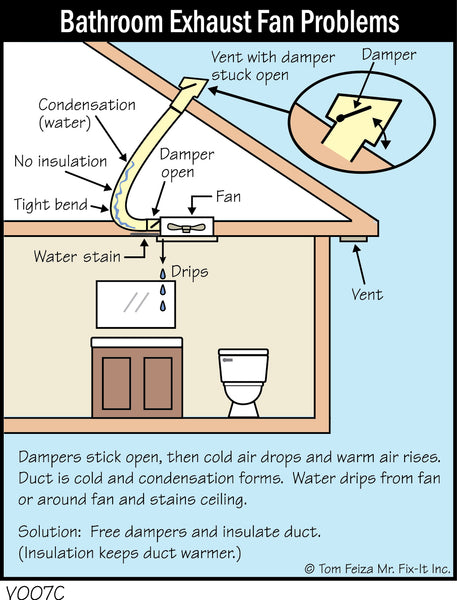Indoor Moisture - Dew Point Basics
Smart Inspector Science
By Tom Feiza, Mr. Fix-It, Inc. | HowToOperateYourHome.com
Many moisture issues are related to the dew point temperature of the air. Dew point confuses some people, but it’s just basic science. If the outdoor air temperature drops below the dew point temperature, condensation occurs as rain. You’ve seen how it rains when a cold front moves in. If the temperature of a hard surface is below the dew point temperature of the air in contact with that surface, water condenses on the surface.
Invisible water vapor is always present in the air. When that air contacts a surface below the dew point temperature, the invisible vapor condenses as visible moisture. If you see moisture forming on a surface, think: “The temperature of the surface is below the dew point temperature of the air.” That’s all you need to remember.
Take it inside
What does dew point mean to home inspectors? We need a basic understanding of the dew point to understand several issues. For instance, think of a drafty old house in a cold climate. Air leaking in from the outdoors made the interior of this house cool and dry – and kids had great fun shuffling their feet on the rug to create shocks from static electricity.
Illustration M054 shows that when we take typical outside air at 30 degrees F and 80% relative humidity and heat it to 70 degrees F indoors, the relative humidity drops to 20% but the dew point stays at 25 degrees F. That cold outside air moves into a home and really dries it out. There is no condensation on interior surfaces, because the indoor temperature is above the dew point of 25 F.

Think about a bath fan with dripping around the housing or below the discharge (illustration V007). When the damper sticks open, warm air moves up into the cold duct or cold air drops into the duct. The duct is below the dew point temperature of the air, and moisture forms.

Another example is condensation on windows (illustration D090). Window glass is often the coldest surface in the home. Cold air drops along the glass to the sill. The glass, cooled by the outdoor temperature, is below the dew point temperature of the air, and condensation forms. If the temperature is below 32 degrees F, ice will form. In a warm climate, condensation will form on the outside of the glass because the glass is cooled by the air conditioning below the dew point of the outside air.

Your message on window condensation
What should you tell customers with window condensation problems? “The temperature of the glass is below the dew point temperature.” There are two ways to remedy this: raise the temperature of the glass, or reduce the moisture in the air.
Tom Feiza has been a professional home inspector since 1992 and has a degree in engineering. Through HowToOperateYourHome.com, he provides high-quality marketing materials that help professional home inspectors boost their business. Copyright © by Tom Feiza, Mr. Fix-It, Inc. Reproduced with permission.

